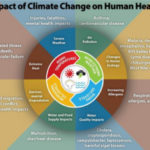By Emma Bittar, Youth Advisory Council Member
Emma Bittar is a college freshman at Tufts University from Bradenton, Florida. She believes that youth have the fundamental right to live their happiest and healthiest lives through equal access to education and healthcare services.
Growing up in Florida has allowed me to appreciate the stunning environment around me immensely. The sprawling pearl-white beaches that contrast against the beautiful turquoise ocean water, warm weather, and beautiful year-round greenery comprise my idea of home. But climate change threatens all of this, amongst many other things.
Climate change knows no boundaries, making it a direct danger to every town, city, state, and country across the world. An article written in 2019 states that “the changing climate, including longer and hotter summers, more frequent and intense storms, sea-level rise, more severe droughts, and poorer air quality, are inextricably linked to poorer health.”1 As such, climate change must be considered its own social determinant of health due to the detrimental impact it can have—and already has had—on health.
As providers, we must consider the intersection of climate change and health when suggesting treatment and resources. To get started, I will highlight some examples of how climate change may directly or indirectly exacerbate various health conditions.2
As providers, we must consider the intersection of climate change and health when suggesting treatment and resources.
If regulations are not put into place, our air quality may decline significantly with time. This can impact our lungs and worsen cases of asthma. Additionally, the increased occurrence of wildfires pollutes the air tremendously for surrounding communities.
Vector-Borne Diseases
The climate significantly impacts animals that carry diseases such as fleas, ticks, and mosquitoes. Increased temperatures may contribute to the increased prevalence and distribution of these diseases, including Lyme, dengue fever, and the West Nile Virus.
Crop yield, fish production, and livestock production are all expected to decline because of climate change. Additionally, more frequent floods and droughts may decimate crop populations. Not only are food shortages possible, but price increases should be expected. This means that many people may experience food insecurity. If they have access to food, it may be nutrient-poor and calorie-rich food, leading to malnutrition and obesity.
Temperature Extremes
Just over a few months ago, the United States watched as Texans suffered horrific conditions due to frigid temperatures. Power outages and lack of access to water were direct results, and many people died because of it. On the other end of the spectrum, tremendous heat can cause cardiovascular, kidney, and respiratory issues. Recently, it has been reported that more frequent and severe heatwaves have led to an increase in death rates.
Natural Disasters
More frequent and more severe natural disasters such as hurricanes, floods, wildfires, droughts, and snowstorms can directly impact most of the areas already highlighted above. It can cause homelessness, food insecurity, displacement, and trauma. Research has shown that experiencing traumatic events like the ones listed can lead to increased stress, anxiety, and PTSD.

An important but relatively unknown concept to also consider in this conversation is the idea of climate gentrification. Climate gentrification is when wealthier populations move to areas less exposed to the effects of climate change, displacing lower-income or vulnerable communities in the process. This can further worsen the health impacts that I have mentioned above.
I’ve highlighted above just a few examples of the link between climate and health, and I fear that we may see more connections with time as conditions may worsen. Even if we find a way to mitigate and slow down the effects of climate change, it is vital as health providers that we face the reality that now, more than ever before, our natural environments directly impact our health and well-being. To ignore this reality would be a disservice to the people that we serve.
To ignore this reality would be a disservice to the people that we serve.
For more information, the CDC has an excellent website that discusses the impact of climate change on health by region and condition, as well as providing prevention resources:
https://www.cdc.gov/climateandhealth/
References
- Ragavan, Maya I., et al. “Climate Change as a Social Determinant of Health.” American Academy of Pediatrics, American Academy of Pediatrics, 1 May 2020, pediatrics.aappublications.org/content/145/5/e20193169/tab-article-info.
- “Climate and Health Program.” Centers for Disease Control and Prevention, Centers for Disease Control and Prevention, 21 Apr. 2021, www.cdc.gov/climateandhealth/default.htm.

